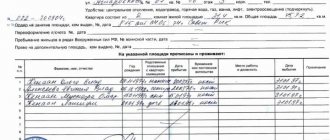Emergency house: what is it?
A house is considered unsafe if it is recognized in accordance with the established procedure as unfit for habitation. The grounds for recognizing housing as unsafe are indicated in the Decree of the Government of the Russian Federation dated January 28, 2006 No. 47 “On approval of the Regulations...”:
- Destruction or deformation of the structure of a house, if living in it cannot be called safe, and major repairs are impossible or impractical from a financial point of view.
- If the house is located in an area where mudflows and landslides are possible; inundation by flood waters. Provided that possible destruction cannot be prevented.
- If the housing is located in an area where accidents are likely to occur, in which it cannot be protected from destruction.
- If the house is located in an area where a constant excess of the level of electromagnetic, ionizing radiation, vibration, and noise is recorded.
Note: a house is recognized as unsafe by decision of the administration after an inspection by an interdepartmental commission, which usually includes employees of the Ministry of Emergency Situations, the Urban Planning Committee, and the Housing and Communal Services Department. If it can be repaired, emergency status will be denied.
Take the survey and a lawyer will tell you for free how to avoid mistakes in an apartment purchase and sale transaction in your case
Is it possible to privatize an apartment in a dilapidated building for free?
Features of privatization are regulated by the Law of the Russian Federation dated July 4, 1991 No. 1541-1 “On the privatization of the housing stock of the Russian Federation” and the Federal Law dated December 21, 2001 No. 178-FZ “On the privatization of state and municipal property.”
In Art. 4 of Law No. 1541-1 states that housing recognized as unsafe is not subject to privatization under any circumstances. The same applies to dormitories, real estate in closed military camps, and official housing (except for the housing stock of agricultural enterprises).
Is it possible to sell or buy an apartment in a dilapidated building?
Payment of utilities in a dilapidated house
When is privatization of emergency housing possible?
Some people mistakenly confuse the concepts of “emergency” and “dilapidated” housing. The difference between them is:
- The house is considered unsafe by decision of the administration; living in it is unsafe. An apartment in it cannot be privatized. Residents must be accommodated on a first-come, first-served basis.
- Dilapidated means housing in unsatisfactory condition, but you can live in it safely. Apartments in dilapidated buildings are subject to privatization if residents have such a right. New property will not be issued to replace old property.
Conclusion: if the house is dilapidated, but suitable for living and is not considered unsafe, you can privatize an apartment there.
Are you tired of reading? We’ll tell you over the phone and answer your questions.
Other possibilities
Considering that the right of privatization can only be used once, it is advisable to correctly implement it.
Sometimes it makes no sense to spend money on a re-examination and privatize emergency housing if it is not valuable for other reasons (for example, a particularly liquid territory, beautiful landscape, infrastructure, etc.).
If premises in a dilapidated building are used by a tenant under a social tenancy agreement, they are required to provide him with an apartment of the same size in the same locality upon demolition of the house. Housing for relocation must comply with the requirements of the law (be comfortable). The chances of moving into a new building are very small, but if the house is demolished, an apartment will be provided in a secondary housing stock that is in better condition.
The advantage of refusing to register emergency housing as the property of the tenant is that the technical condition of the other house and apartment in it will be better. Having privatized such an apartment, if necessary, it is easier and simpler to sell or exchange it than an emergency one.
This is important to know: Privatization of land in SNT
Privatization of dilapidated housing: pros and cons
Let's consider the advantages and disadvantages of privatizing an apartment in a dilapidated building:
Advantages and disadvantages
No need to spend money on buying a home. Even in the regions, apartments in the oldest buildings cost from 1 million rubles. Privatization makes it possible to obtain real estate for free
If the house is recognized as unsafe, the owner can count on compensation for the purchase price or the provision of a new apartment
You can register anyone. If the living space belongs to the municipality or the state, and a person lives there under a social tenancy agreement, only close relatives can be registered without the consent of the owner. To register outsiders, the consent of the owner is required
If a minor participates in privatization, upon reaching 18 years of age he will again be able to privatize real estate
Having received ownership of the apartment, you can dispose of it at your own discretion: sell, donate, exchange, bequeath
If the owner accumulates debts for housing and communal services, the apartment will not be taken away. When living under a social tenancy agreement, the landlord, if there is arrears for 6 months, has the right to evict the tenants through the court
You can do redevelopment. In a non-privatized apartment this is possible only with the consent of the landlord
The right to privatize adults is granted only once. In the future, it will not be possible to receive real estate from the state for free.
Under the social tenancy agreement, the landlord undertakes to maintain the residential premises in proper condition. After privatization, this responsibility falls on the owner
If one of the owners who participated in privatization has not lived in the apartment for a long time, he cannot be discharged
You will have to pay property taxes annually
Utility costs will increase. The line “hiring fee” will disappear, but “payment for major repairs” will appear.
Privatization of dilapidated housing
In 2021, by decree of the Government of the Russian Federation, a decision was made on the indefinite nature of the program for transferring housing into private ownership. Privatization of dilapidated real estate is carried out according to a standard procedure. A detailed description is in the thematic publication at this address. Below is the basic information in abbreviated form.
List of documents
The following documents must be prepared for housing privatization:
- civil passports of adult residents or other identification documents;
- birth certificate of children under 14 years of age;
- notarized powers of attorney from temporarily absent privatization participants;
- a valid social tenancy agreement;
- confirmation from the management office that there are no debts for utility services.
Attention! On our portal you can apply for the privatization of an apartment and for the refusal of privatization.
Procedure
To privatize a dilapidated apartment you need to go through the following steps:
- After preparation, the basic package of documents is transferred to the authorized unit of the local administration. The registration date is recorded in the journal of incoming applications.
- If there are no errors, a special housing privatization agreement is drawn up and signed. It is transferred to Rosreestr.
- The process ends with a change in the USRN database of the record about the new owners. Similar actions with a delay of up to 2 days can be performed through the MFC.
Before privatizing emergency housing, all the pros and cons should be comprehensively assessed, taking into account the features noted above. It is recommended to further study the conditions that apply in a particular municipality.
Repost, like, leave comments in the comments. To get professional help, contact the duty lawyer.
For a detailed study of the process of selling emergency housing, use thematic materials on our website.
Who can privatize an apartment?
The following categories of citizens have the right to participate in privatization:
- Minor children registered in a municipal apartment. Refusal from privatization is possible only with the consent of the guardianship authority.
- Adult registered residents.
Note: adult family members can refuse privatization and subsequently privatize other housing. The refusal must be made in writing. If a child has privatized housing, after 18 years of age he can again participate in privatization.
How to privatize emergency housing?
To privatize an apartment in a house that is in disrepair in the opinion of tenants, you need to:
- Collect documents, prepare applications, issue refusals (if any).
- Submit documents for consideration.
- Receive an agreement on the transfer of housing ownership and sign it.
Let's look at each step in more detail.
Step 1: preparation of applications and documents
For privatization you will need:
- Statement.
- Passports of all registered family members over 14 years of age.
- Birth certificates for children under 14 years of age.
- Social tenancy agreement.
- Order.
- Extract from the house register.
- Certificate confirming the right to participate in privatization.
- Written refusals or consent of family members to privatization.
Note! The refusal to privatize is valid for 30 days. It is better to complete it immediately before submitting your application.
Sample application
Consultation on document preparation
Sample application
Consultation on document preparation
Contents and sample application
An application for participation in the privatization of dilapidated (dilapidated) housing is filled out on site when submitting documents. It contains the following information:
- Full name, passport details, date of birth, SNILS of the applicant.
- Registration and actual residence addresses.
- Phone number, email address.
- To whom the application is addressed: full name of the owner, full name. official.
- Request for the provision of services for the privatization of premises.
- Address of the privatized apartment,
- Method of providing a solution: in person, by post.
- Consent to the processing of personal data.
- Date of compilation, signature with transcript.
Step 2: Submitting documents
Documents can be submitted through the MFC or State Services. The second method is available for users with verified accounts.
Legal advice: as of October 2021, in most regions, MFCs are accepted by appointment. This is very convenient: just come 10 minutes before your appointment, enter the code and receive a coupon. There is no need to wait in line; reception is carried out in a timely manner.
Elena Plokhuta
Lawyer, website author (Civil law, 7 years of experience)
Note: state duty for re-registration of ownership in the amount of 2,000 rubles. payable on the spot. A payment receipt is not always needed. Now all services can be paid for at the MFC using bank cards. It is advisable to keep the payment receipt if payment is made by another method.
Step 3: getting the result
Based on the results, an agreement is issued on the transfer of ownership of residential premises between the municipality and tenants with a note on registration of the transfer of ownership (Article 7 of Law No. 1541-1).
If documents were submitted through State Services, when signing the agreement you need to take with you the social rent agreement, warrant and notarized documents that were attached to the application.
Deadlines
Documents are reviewed within two months from the date of submission of documents (Article 8 of Law No. 1541-1).
Price
The privatization itself is free of charge. But for the transfer of ownership you need to pay a state duty in the amount of 2,000 rubles.
Additional costs may also arise:
- Registration of a notarized power of attorney – about 5,000 rubles. It is needed if a representative acts on behalf of the future owner.
- Debt settlements. Until the debt on housing and communal services is repaid, the tenant will not be able to privatize the housing.
- Registration of refusals to participate in privatization with a notary – up to 5,000 rubles. for every.
Grounds for refusal
Privatization can be refused in several cases:
- An incomplete set of documents is presented.
- The submitted documents do not meet the requirements.
- There is no right to privatization.
- Documents have been submitted for housing, which by law cannot be privatized.
Note! The decision to refuse is issued to the applicant in writing. If he does not agree with it, it can be challenged in court. Sometimes the procedure is suspended, the reason must be communicated. They need to be eliminated, and the process will be resumed.
How to privatize an apartment in dilapidated housing
Privatization of an apartment in a dilapidated building is carried out on a general basis. However, approval issues often arise. State structures, fully aware that in the near future home owners will have to pay significant compensation (after all, there is not much free housing and not everyone agrees to move to the apartment provided by the municipality) due to the need to demolish the house, prefer to refuse privatization. It is much easier for them to move people to other social housing and then transfer ownership of it to them on a general basis than to pay money directly. However, this is a violation of the law and such refusals can be fought through the courts.
Order, algorithm
The procedure for the privatization of dilapidated housing is no different from the usual privatization of an apartment through the MFC (My Documents) or the municipality:
- Collect consent from all apartment residents.
- Prepare documents.
- Make a statement.
- Send the application and documents to the MFC (My Documents) or the municipality.
- Get a solution.
- Sign the privatization agreement.
- Register ownership in Rosreestr.
Procedure
The first stage is collecting consent for privatization from all apartment residents. You need to understand that this applies only to those persons who officially have the right to live in the premises (are registered in it). Alternatively, if they do not want or cannot (privatization is available only once in a lifetime) to participate in privatization, then they can write a refusal to participate in this procedure. However, if a person is categorically against the process itself (does not want to give consent, but does not refuse to participate), then privatization will become impossible.
Example : One of the residents previously participated in privatization and therefore cannot go through this procedure again. He will formalize and provide a notarized waiver of participation. If the other tenant is fundamentally against it and does not want to refuse (but does not give consent either), the others will have to negotiate and convince him.
After this, you need to start collecting documents. This, as practice shows, takes the most time and effort. An application for privatization can be completed immediately, or you can fill out the form on the spot when submitting documents. The procedure itself is carried out either at the municipality or through the MFC (My Documents). The first option is a little faster, but the second is usually much more convenient.
After submitting the application and documents, you will have to wait for a decision. If it is positive, all that remains is to sign the privatization agreement and go with it to Rosreestr to register ownership of this object.
The fact that the house is dilapidated does not need to be indicated anywhere. Moreover, since there is no such concept in the law, it can be completely ignored and the apartment can be privatized on a general basis. And only if, instead of permission for privatization, a refusal of this procedure is issued on the grounds that the house is considered dilapidated, can you go to court.
Expenses
Privatization of an apartment is considered free and, as of 2021, indefinite. There is no need to rush anywhere anymore. However, as part of the procedure itself, certain expenses will still arise. Although they still cannot compare with the real cost of the apartment (even in a dilapidated building):
| Type of expenses | Amount of expenses |
| State duty for registration of property rights | 2000 rubles per tenant |
| Refusal to participate in privatization | Up to 1000 rubles |
| Extract from the Unified State Register of Real Estate | From 300 rubles |
| Extract from the house register | 200 rubles |
| Registration of a technical passport | From 1000 rubles |
If you use the services of a representative, you will additionally need to issue a power of attorney for him. This will cost about another 2-5 thousand rubles.
Example : Suppose a person wants to privatize an apartment. In addition to him, two more live in it, one of whom refuses to participate in privatization and draws up the corresponding document (1000 rubles). Now you need to collect documents: 1000 rubles - a registration certificate, 300 rubles - an extract from the Unified State Register, 200 rubles - an extract from the house register. Once everything has been agreed upon, ownership is formalized. Since out of 3 apartment residents only 2 are participating in the procedure, they must pay a state fee in the amount of 2 * 2000 = 4000 rubles. In total, the total amount of expenses was: 1000+1000+300+200+4000=6500 rubles.
Documentation
The following list of documents must be attached to the application:
- Passports of all residents registered in the apartment.
- For minors who do not yet have a passport - a birth certificate.
- If you plan to privatize an apartment with minors, you need permission from the guardianship authorities.
- Technical passport.
- Extract from the Unified State Register of Real Estate.
- Extract from the house register.
- Statement of the personal account of the apartment.
- Consent to privatization or refusal to participate in the procedure.
Refusal to participate in privatization automatically deprives the person who refuses of his/her allotted share of the apartment.
Application for privatization of an apartment
Deadlines
From the start of the procedure until the registration of ownership rights, it usually takes 3-4 months. Of them:
- Up to 1 month to collect documents.
- Up to 2 months for processing the application.
- Up to 1 month registration of ownership.
Lawyer's answers to private questions
Is it necessary to have a privatization agreement for an apartment in a dilapidated building certified by a notary?
No. According to Art. 7 of Law No. 1541-1, notarization of the agreement is not required.
Is it possible to privatize an emergency private house?
No. Any emergency housing (house, apartment, other premises) cannot be privatized. If it is simply dilapidated, it is possible to re-register ownership with the consent of the municipality.
Until what year is free privatization valid?
Privatization is valid indefinitely. Such a law was adopted by the State Duma back in February 2021. The norms that limited the deadlines until 2021, Art. 1 Federal Law dated February 22, 2017 No. 14-FZ was declared invalid.
Before privatization, I lived with my husband; he gave up his share and was registered in the apartment. Now the housing has been privatized, we got divorced. Can I write it out?
No you can not. According to Part 3 of Art. 31 of the Housing Code of the Russian Federation, the former spouse’s right to use the apartment does not terminate if at the time of privatization he had equal rights to housing with the owner.
How are shares determined when privatizing an apartment in a dilapidated building?
The parties themselves determine the size of shares by agreement. In the absence of such, equal shares are allocated (Article 245 of the Civil Code of the Russian Federation). But it is also possible to register it as joint ownership without allocating shares.
Deprivatization procedure
Deprivatization is not the most popular and not a particularly simple procedure. It is recommended to use the services of experienced lawyers who will represent the interests of clients. Below is an approximate procedure. It may vary slightly depending on your region of residence.
Procedure
- Collect consents from all registered residents of the apartment and have them certified by a notary (usually the personal presence of all persons who wrote these consents is required).
- Submit an application for deprivatization (usually it is best to do this right at the time of application, but you can prepare it in advance).
- Prepare all the necessary documents (see below for more details).
- With documents and an application, contact the nearest branch of the MFC (My Documents) and declare your desire to deprivatize housing.
- Receive a receipt for the application. This is mandatory, otherwise documents may be “accidentally lost.” Any action must be supported by relevant papers.
- Expect a deprivatization agreement. This document is prepared by specialists and the apartment owners cannot influence this process in any way. It is recommended to check regularly, at least once a week, about the fate of the application, since it is not a fact that the MFC will notify applicants that the agreement is ready.
- The deprivatization agreement must be signed by all interested parties. But they don't take him away. Immediately after signing, MFC employees pick it up again and transfer it to Rosreestr to change the ownership of the property.
- After this, the contract is finally issued to the residents, but this is not the end of the procedure. Now the DGI (Department of City Property) must draw up a social lease agreement (it may be called differently). And only after this, when this document is signed, the residents receive the right to lifelong residence in the deprivatized apartment.
Documentation
Along with the application for deprivatization, the following documents must be submitted to the MFC:
- Title documents on the basis of which the residents previously privatized this apartment (originals required).
- Extract from the Unified State Register of Real Estate (shows ownership and confirms the absence of encumbrances). It is recommended to order this document immediately before contacting the MFC in order to provide the most recent sample.
- Extract from the house register. Provided for the period from the moment of privatization until the moment of application to the MFC.
- A certificate from the management company or housing office confirming that there is no debt for utility bills.
- Registration certificate for the apartment.
- Passports or birth certificates for all residents of the apartment.
- Permission from the guardianship authorities to deprivatize the apartment (provided that minors are registered in the housing).
This is important to know: Transferring your share in a privatized apartment to a relative
Expenses
The deprivatization procedure itself is free. However, certain costs may still arise. Of these, the most basic is payment for notary services when certifying the consents of apartment owners. Other expenses:
- New registration certificate: from 10 thousand rubles.
- Fresh extract from the Unified State Register of Real Estate: 350 rubles.
Deadlines
Deprivatization is a lengthy procedure, and not all deadlines can be clearly defined. It might look something like this:
- Collection of consents and documents: from 1 day.
- Submitting an application to the MFC: from 1 day.
- Consideration of the application and drawing up a deprivatization agreement: about 2 months.
- Change of ownership in Rosreestr: about 1-2 weeks.
- Obtaining a rental agreement for municipal housing: about 2 weeks.
FREE CONSULTATIONS are available for you! If you want to solve exactly your problem, then
:
- describe your situation to a lawyer in an online chat;
- write a question in the form below;









